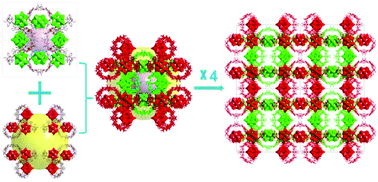A nonconventional host–guest cubic assembly based on γ-cyclodextrin and a Keggin-type polyoxometalate†
Abstract
Supramolecular self-assembly allows components to organize themselves into regular patterns by using non-covalent interactions to find the lowest-energy configuration. However, self-assembling organic and inorganic building blocks together into an ordered framework remains a challenge due to the difficulties in rationally interfacing two dissimilar materials. Herein, we report on the host–guest ensemble of polyoxometalates (POMs) using cyclodextrins (CDs) as the trapping agent to form POM@γ-CD entities. Two unprecedented super cubic isostructures, Co/Cu-PW12O40-γ-CD, were obtained. The self-assembly has been observed both in solution (MS, 1D NMR and 2D DOSY) and in the solid state. Single-crystal X-ray diffraction reveals that in a unit cell, the inner (POM@γ-CD)12 cube is encapsulated by the outer (POM@γ-CD)24 cube. Besides, due to the rather large spherical voids, two (POM@γ-CD)24 cubes are interspersed together. Preliminary investigations of the redox properties of the [PW12O40]3− encapsulated in the γ-cyclodextrins indicate that the redox properties of the trianion are largely retained, yet an additional electrochemical stabilization is observed. The adduct reported here opens the door to a new generation of hybrid materials with tuned structures and customized functionalities.



 Please wait while we load your content...
Please wait while we load your content...